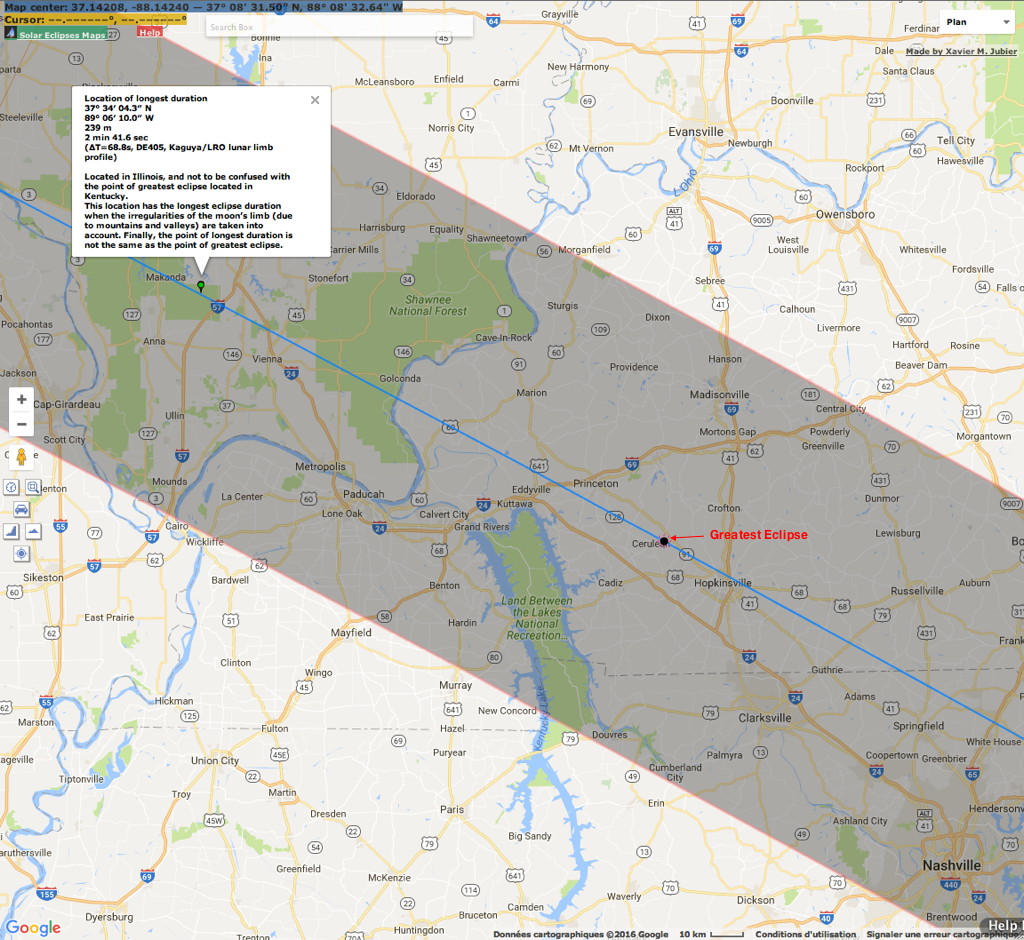
|
Total Solar Eclipse of 2017 August 21
Totality Duration & Terminology
#eclipse2017, #tse2017, #2017eclipse
|

|
|
|
Lately there has been some discussions about the terms used to describe and qualify a solar eclipse and in particular its umbral duration. People will often hear about "greatest eclipse", "greatest duration", "longest duration", "longest eclipse", "corrected longest duration" or even "uncorrected longest duration". I have to admit it can be confusing to most, nevertheless you have to know that the small differences between the different expressions are meaningless to most and will not have any real impact on your eclipse experience. The key is first to see it, which means with a sky that is clear enough around the eclipsed Sun, after which duration is secondary.
So to understand what is really behind those expressions, just keep reading.
|
|
|
|
The difference in umbral duration between the locations of the different definitions is a mere couple of seconds at most, so completely insignificant. However these locations can be over a couple hundred miles or kilometers distant.
Greatest Eclipse is defined as the instant when the axis of the Moon’s shadow cone passes closest to Earth’s center. The computation of the duration of the total (or annular) phase at this point is done purely in a geometrical way using a smooth edge for the Moon that ignores the effects of mountains and valleys along the lunar limb. For total solar eclipses, the instant of Greatest Eclipse offers a good approximation (typically ≈1-2 seconds) to the Greatest Duration or Longest Duration of totality along the entire eclipse path. The instant of Greatest Eclipse is easily calculated for total, annular and partial eclipses, and is the standard time used for comparing different eclipses with each other.
Greatest Duration is defined as the instant when the length of the total (or annular) phase reaches a maximum along the central path of a solar eclipse, that is computed again in a purely geometrical way using a smooth edge for the Moon that ignores the effects of mountains and valleys along the lunar limb. So Greatest Duration is necessarily uncorrected. There is no explicit or analytical solution for the determination of Greatest Duration.
Longest Eclipse is the same as Greatest Duration.
Longest Duration can be either uncorrected, in which case it will be identical to Greatest Duration, or corrected in which case the lunar limb profile and eventually the local terrain elevation will be taken into account. As a result the corrected Longest Duration will not be on the centerline. The "corrected" adjective is not necessarily always mentioned, so just look at if the author of the work is making lunar limb corrections and it will provide you the answer. There is no explicit or analytical solution for the determination of Longest Duration.

What then about bragging rights? Well don’t pay to much attention to this because it has nothing to do with the total solar eclipse you’re looking forward to experience. Just pick a cloud-free spot inside the central eclipse path and enjoy it!
To summarize, don’t pay too much attention to duration, make sure your location will have clear skies and that it is inside the central eclipse path, that’s all there is to it. Avoid at all costs the partial solar eclipse as if I had to provide an analogy it could be: "I jumped over a crevasse and made it 99.9% of the way. Oops not quite good enough! ;-)" One should never forget that a total solar eclipse is all about YOUR OWN EXPERIENCE, not its duration or other factors.

Cartoons by Bill Kramer

|
How to check your position using your smartphone
 To know in real-time how well you’re doing in terms of position in relation to the totality path you can use this auto-tracking geolocation tool
To know in real-time how well you’re doing in terms of position in relation to the totality path you can use this auto-tracking geolocation tool
http://xjubier.free.fr/tse2017map?Map=ROADMAP
or a more complex map (all the URL on one single line with no spaces)
http://xjubier.free.fr/xSE_GM?Ecl=+20170821&Acc=2&Umb=1&Lmt=1&Mag=1&Max=1&MapT=ROADMAP
Remove the ?Map=ROADMAP at the end of the URL if you want to stay in the default SATELLITE mode. Of course the map mode can still be selected once the map is loaded. And the road traffic can be displayed as well.
The tool has been tested with success on a variety of devices from iOS to Android, Windows Phone and Blackberry. Nevertheless please report any problem you may encounter and don’t forget to provide a screenshot and a detailed description.
Then to activate the tool click on the lower icon on the left side, the one looking like a blueish shooting target  . Once activated you should be prompted to accept being geolocated, so answer positively and the map should center on your current position and track your movements (it will work as well on a desktop computer connected via an Ethernet cable and even better via Wi-Fi). To deactivate the tool and stop the tracking click again on the button. . Once activated you should be prompted to accept being geolocated, so answer positively and the map should center on your current position and track your movements (it will work as well on a desktop computer connected via an Ethernet cable and even better via Wi-Fi). To deactivate the tool and stop the tracking click again on the button.
Depending on your device you may have to authorize geolocation in the general settings as well. For example on iOS or OSX you should do so in the privacy settings.
The detailed circumstances bubble is disabled while the auto-tracking geolocation is activated in order not to clutter the screen too much.
More detailed information there
http://xjubier.free.fr/en/site_pages/solar_eclipses/xSE_GoogleMap3_Help.html#geolocation
|
|
|
|
|
|
|





